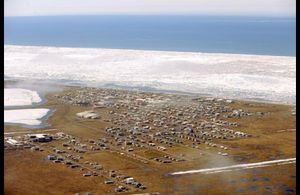Group A - Collaborative Climate Adaption Project
| Place | Barrow | |
| Country | Alaska | |
| Topic | Effects of climate change and adaptation possibilities - case study from Barrow, Alaska | |
| Author(s) | Palmowska Agnieszka, Shrestha Neha, Szilagyi-Nagy Anna | |

| ||
| Source | http://www.alaskadispatch.com | |
|
| ||
Rationale: Why have you selected this case study area?
- We have selected the area of the city Barrow, which is located in the north of Alaska, because this area is a perfect example to show that climate change is really progressing and causes the changes in many main areas of life. Barrow is known as the "Ground Zero for Climate Change".
- To select this area also encouraged us Dr. Klaus Görgen who talked about problems in Barrow, Alaska, during the first online seminars.
Authors' perspectives
- We are a landscape architects so we are closely associated with the climate, and also we have to constantly adapt to climate change. Showing the problem from the perspective of a place so distant may be helpful in understanding the general problem of climate change and will expand our knowledge about this topic.
- It is important that everyone should be aware that climate change is a global problem and its consequences are visible even in the farthest regions of the world.
Landscape and/or urban context
- Biogeography, land use patterns, cultural features, overall character, history and dynamics
- ratio of green/blue and sealed/built-up areas
Illustration: Map; sketches; short descriptive analyses Urban contex of city Barrow
The immediate Barrow situated in Alaska, in the largest and nordernmost state in U.S. (1,477,300 km2, it extends, to the Eastern Hemisphere so the westernmost and easternmost as well) which has more ocean coastline than all of the other U.S. states combined (6640 miles). http://www.fas.org/sgp/crs/misc/RS21729.pdf and a capital, Juneau, that is only accessible via ship or air. Barrow is the most famous city of the Northern Economic Region, because it is northernmost town in the United States. This region is the remote, less crowded part of the state, encompassing 380 native villages and small towns such as Nome, Bethel, Kotzebue, King Salmon, Dillingham, and includes Katmai National Park, Kodiak Island, and Unalaska-Dutch Harbor. With approximately 4,500 residents, the Barrow area has probably the harshest weather in Alaska. It is one of the world's largest Inupiat Eskimo settlement where traditional culture and modern life are blended. While many modern conveniences are available, the subsistence life style is still very much in evidence, and fishing, hunting, and whaling are a way of life. North Slope oil discovery has brought wealth to the area, including modern influences such as snowmobiles, but it has been continuously occupied for 5,000 years by people who have learned how to live in the harsh arctic climate. The sun shines and never sets for 82 days from early May to early August and it is dark for 51 - 67 days (the sun never rises) between November and January. (http://fairbanks-alaska.com/barrow.htm)
Cultural/social/political context
- Brief explanation of culture, political economy, legal framework
Illustration: Bullet points, image, background notes
Local Climate
- What are the climatic conditions at present? Have there been extreme weather events in the near past?
- Which changes are expected? Is there any evidence?
Illustration: Table or time line
Analysis of vulnerability
- If you consider these potential changes - which aspects/functions of your case study would be affected?
Illustration: Map/diagram/sketches/photos/background notes
Proposals for Climate Change Adaption
- How could your case study area become more resilient to climate change?
- Which measures would need to be taken to adapt to the new situation?
- How could you assure sustainability of these measures?
- Please describe 2-3 measures
Proposals for Climate Change Mitigation
- Which measures would need to be taken to reduce greenhouse gas emissions and other drivers of climate change within your case study area?
- How could you assure sustainability of these measures?
- Please describe 2-3 measures
Your scenario
- How will this area look like in 2060?
- Please forecast one potential future development taking climate change into account
Illustration: Map/diagram/sketches photos and background notes
What can be generalized from this case study?
- Are there any important theoretical insights?
- Which research questions does it generate?
- Short statement plus background notes
Image Gallery
- Yourimage.jpg
your image text
- Yourimage.jpg
your image text
- Yourimage.jpg
your image text
- Yourimage.jpg
your image text
- Yourimage.jpg
your image text
- Yourimage.jpg
your image text
- Yourimage.jpg
your image text
- Yourimage.jpg
your image text
References
Source of jpg: http://www.alaskadispatch.com
About categories: You can add more categories with this tag: "", add your categories